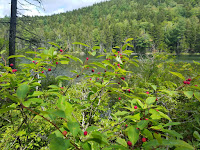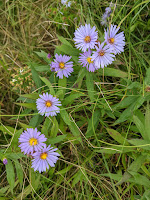 |
Mountain Holly (Ilex mucronata)
Borestone Mountain, ME |
Shrubs and woody perennials can be wonderful not only majestic in their appearance in a garden landscape, but also in terms of the resources they provide to insects and birds. Because they can store energy, they often bloom even as the snows melt (e.g. willows) or as the earliest bees appear or signal the return of fish to their spawning grounds (shadbush).
The problem is that unlike smaller plants, they
 |
| Hopefully not to dry... |
represent a major investment of both time and capital. This creates the perfect opportunity for the landscape industry to cut corners by selling cuttings from factory nurseries to our south that lack genetic diversity and are not as well adapted to our climate and the timing of our seasons. Natives can also be replaced with cultivars that do not provide the same benefits. Insects diminish and a recent article
published in Scientific American suggests that bird populations in 2017 were 30% reduced from those in the 1970s. In less than our lifetime, we are seeing changes that while, perhaps not irreversible, bear many of the hallmarks of inevitability.
 |
Arrow wood, Viburnum dentatum
Biddeford Pool Land Trust Maine |
But we can slow or even stop the decline around us one yard at a time if we accept the challenge of restoring nature. Keeping a diversity of shrubs is critical to our ecological resilience. For my part, I have collected wild seeds (berries) over the summer from some amazing shrubs and flowers that, given time, will transform my suburban desert into an oasis of life for insects and birds. In the top photo above is a mountain holly (Ilex mucronata) from which I collected berries near the base and on the summit of Borestone Mountain. These are a bit far to the north of the seacoast but they are still a
host plant according to the National Wildlife Federation database for numerous caterpillars in our area.
 |
| Arrow wood, Sept 1, 2019. |
Arrowwood,
Viburnum dentatum, is a gorgeous shrub that I have seen covered in all kinds of insects. It is named 'dentatum' because of the toothed ridges on its leaves. I have read that this particular variety of viburnum is susceptible to the viburnum leaf beetle but the viburnums (there are several native to our region) are
excellent host plants and also a good fall food source. I collected these from Biddeford Pool Maine on property acquired by the local land trust. It is a gorgeous location to visit any time of year. There is a boardwalk off the public beach and the
insect and plant life during the summer never disappoints. I believe Maine Audubon also has a sanctuary with some lovely shrub and meadow habitat overlooking Wood Island.
The last of the shrubs I have started this year is
bristly sarsaparilla. I found it near Sebec Lake in Bowerbank Maine this August. It is
 |
| Bristly sarsaparilla. |
an interesting plant because I believe it has value both for insects and animals but it can also be used in making beverages such as Maine Root's sarsaparilla which is spicy and fun as a mixer. I found these growing in a couple of early successional habitats near a logging road where the logging opened up the area to wildflowers including pearly everlasting, fireweeds, spirea and other species. I could have spent a week just looking at the plants, butterflies and bees in the area.
 |
| Asters at Seapoint, Kittery Maine. |
I'm really looking forward to seeing what I can get started in the spring of 2020. However, I have to temper my enthusiasm because I have read that these seeds can take up to 2 years to germinate. That's a long time to wait and a big investment of time and space. However, nature has taken thousands of years for our ecosystems to mature. Is that so long to wait to restore the balance that we have carelessly cast aside? If nature is worth protecting, that does not seem long to wait. It may take a few years to get something large enough to call a shrub, but shrubs can be all other rewards for a native gardener.










Comments
Post a Comment